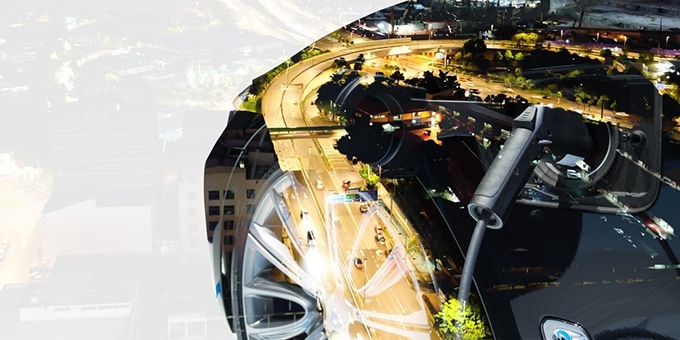New automotive technologies, followed by the growing trend of autonomous vehicles on our roads could improve urban mobility in the future and mitigate the negative environmental impact of conventional transportation.
 Autonomous Vehicles Could Improve Urban Mobility and Mitigate Pollution
Autonomous Vehicles Could Improve Urban Mobility and Mitigate Pollution

Richard van Hooijdonk
Today, more than half of the world's population resides in urban areas. A larger labour market, diverse social interactions, and rich cultural life are just some of the things that attract people to ever-growing cities. But aside from all the benefits, urban areas often suffer from frequent traffic jams and pollution.
New automotive technologies, followed by the growing trend of autonomous vehicles on our roads could improve urban mobility in the future and mitigate the negative environmental impact of conventional transportation. This should, to a large extent, elevate the quality of life in urban environments, and these benefits shouldn’t be overlooked.
Self-driving cars can help alleviate traffic congestion
As the urban population grows, so does the number of cars, which means more traffic and pollution. In fact, recent data shows that there are almost 300 million vehicles throughout Europe, while in the first quarter of 2018, there were around 272.1 million vehicles on US roads. Traffic congestion is already affecting urban areas, increasing the levels of harmful emissions and causing noise pollution. This could be solved by introducing autonomous vehicles (AVs). In fact, a study conducted by a multidisciplinary team of researchers shows that traffic flow can be improved even with a few AVs “immersed in bulk traffic” and controlling the pace of traffic.
Traffic oscillation, also known as stop-and-go traffic, naturally occurs whenever a driver changes lanes or when a car slows down due to heavy traffic, leading to gridlock. The researchers found “that by controlling the pace of the autonomous car in their field experiments, the autonomous car controlled the traffic flow by dissipating the stop-and-go waves so that traffic wasn't oscillating as it does when all of the cars are driven by humans”. What’s more, they also determined that even with only 5% of vehicles in traffic being AVs, total fuel consumption could be reduced by up to 40% and “braking events by up to 99 percent”.
Research conducted at the University of Illinois also demonstrates the impact a single autonomous car can have when introduced to traffic. Namely, the research team used circular traffic simulations to showcase how a vehicle that slows down without an apparent reason can cause a “phantom traffic jam”, where each car in line slows down, and consequently, the traffic grinds to a halt. A single AV included in traffic managed to reduce “the standard deviation in speed of all the cars in the jam by around 50 percent, and the number of sharp hits to the brakes is cut from around nine per vehicle for every kilometer traveled to at most 2.5—and sometimes practically zero”. What’s more, fuel consumption can be cut by up to 40% “when averaged across all the cars in the traffic flow”.
Cities are revamping public transport: autonomous buses for greener cities
Despite safety concerns surrounding self-driving cars, forward-thinking cities are very much open to the idea of integrating autonomous buses into the public transport system. For instance, Neuhausen Rheinfall, a small Swiss town, introduced “an all-electric self-driving bus that's the first of its kind anywhere in the world”. “It's an all-autonomous bus and it's fully embedded into our public transport system here in Schaffhausen. It allows us to drive without a driver,” says Trapeze’s CEO, Peter Schneck. It’s been open to the public since March 2018, and passengers can experience the transportation system of the future while visiting the largest waterfall in Europe, the Rhine Falls. Driving at a speed of 25 km/h, it’s not the fastest vehicle around, but it boasts outstanding performance, operating “throughout the day on a single battery”, while “the bus is typically charged overnight in a process that takes between three to four hours”.
.jpg)
Photo by https://www.shutterstock.com/g/andrey+suslov
And the Swedish capital, Stockholm, introduced a fleet of smart driverless buses. Each carrying up to 11 passengers, these sensor-equipped buses operate on a 1.5 kilometre stretch of road and are connected “to Ericsson sensor-enabled bus stops and traffic lights”. Driving at 20 km/h, these aren’t the speediest vehicles around, but if the pilot project proves successful, “this will be a very common part of Stockholm transport system," assures Kristoffer Tamsons, Stockholm's regional transport commissioner and chairman of Stockholm transport.
What if all cities replace ‘dumb’ vehicles with AVs?
Without clear regulation, smart roads, and purposeful use, more AVs in growing urban areas could potentially “lead to more cars on the road, more congestion and more urban sprawl”. However, according to The International Association of Public Transport’s (UITP) policy brief, titled “Autonomous vehicles: a potential game changer for urban mobility”, AVs could contribute to traffic efficiency and reduce the negative impact on the environment only if they’re “introduced in fleets of driverless shared autonomous vehicles of different sizes reinforcing an efficient high capacity public transport network supporting walking and cycling”.
Safety concerns and scepticism, however, have put some shade on the idea of AVs revolutionising transport. Nevertheless, with improved self-driving tech and roads to serve them, there’s no doubt that autonomous vehicles will make daily commutes more pleasant, faster, and safer.
 About Richard van Hooijdonk
About Richard van Hooijdonk
International keynote speaker, trend watcher and futurist Richard van Hooijdonk offers inspiring lectures on how technology impacts the way we live, work and do business. Over 420,000 people have already attended his renowned inspiration sessions, in the Netherlands as well as abroad. He works together with RTL television and presents the weekly radio program ‘Mindshift’ on BNR news radio. Van Hooijdonk is also a guest lecturer at Nyenrode and Erasmus Universities.
Sources
- https://www.acea.be/statistics/tag/category/vehicles-in-use
- https://www.bcg.com/industries/automotive/self-driving-vehicles-car-sharing.aspx
- Condliffe, Jamie, https://www.technologyreview.com/s/607841/a-single-autonomous-car-has-a-huge-impact-on-alleviating-traffic/
- https://edition.cnn.com/2018/06/27/sport/trapeze-self-driving-autonomous-electric-bus-switzerland-spt-intl/index.html
- Engberg, Ulla, https://sverigesradio.se/sida/artikel.aspx?programid=2054&artikel=6869391
- Farmbrough, Heather, https://www.forbes.com/sites/heatherfarmbrough/2018/01/31/ugly-but-useful-stockholm-introduces-driverless-busses/#55d44cbb60f4
- Leong, Jeanne, https://phys.org/news/2018-02-autonomous-vehicles-traffic.html
- Metcalfe, Tom, https://www.livescience.com/61862-why-phantom-traffic-jams-happen.html
- Oliver, Nick, Kristina Potočnik, Thomas Calvard, https://hbr.org/2018/08/to-make-self-driving-cars-safe-we-also-need-better-roads-and-infrastructure
- Patterson,Jayda, https://www.entitymag.com/5-reasons-people-move-big-cities/
- https://www.smatstraffic.com/2017/05/18/costs-of-congestion-the-environment/
- https://www.statista.com/statistics/859950/vehicles-in-operation-by-quarter-united-states/
- https://www.uitp.org/news/autonomous-vehicles-urban-mobility
- https://www.uitp.org/sites/default/files/cck-focus-papers-files/PolicyBrief_Autonomous_Vehicles_LQ_20160116.pdf
- https://www.un.org/development/desa/en/news/population/2018-revision-of-world-urbanization-prospects.html
- Wiggers, Kyle, https://venturebeat.com/2018/08/25/self-driving-cars-have-a-long-road-to-becoming-transportations-future/
The content & opinions in this article are the author’s and do not necessarily represent the views of RoboticsTomorrow
Comments (0)
This post does not have any comments. Be the first to leave a comment below.
Featured Product

